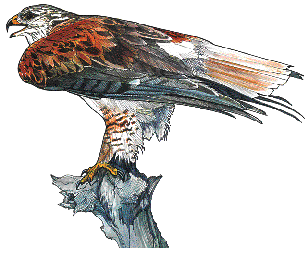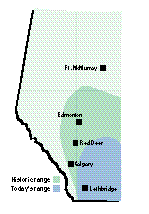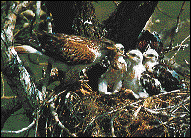 The
Ferruginous Hawk (Buteo regalis)
The
Ferruginous Hawk (Buteo regalis)
 The
Ferruginous Hawk (Buteo regalis)
The
Ferruginous Hawk (Buteo regalis)
Status: In the early 1900s, ferruginous hawks nested throughout south and central Alberta as far north as Edmonton. By 1987, nesting birds were found no further north than Coronation. Biologists estimate there are now 1,400 to 1,700 breeding pairs in the province, over half the Canadian population.
Habitat: Uncultivated pasture on the Prairies and arid grasslands of western North America.
Appearance: Largest hawk in North America. Heavy, thick-set birds with broad powerful wings. Adult females may be up to one-and-a-half times larger than the males.
The name "ferruginous" comes from the Latin word ferrugo, meaning rust, for the rusty brown on their shoulders, back, rump and legs.

Food: Gophers make up nearly 90 per cent of their diet. While raising their young, one pair of hawks consumes an average of 480 gophers. In Alberta, they may also eat voles, mice and white-tailed jack rabbits.
Breeding: This species builds big, bulky nests in isolated trees, on rocky ledges or occasionally on the ground. A breeding pair may have up to five nests in their territory but use only one each year.
The female lays three to five eggs and incubates them for about a month. The eggs hatch around the time young gophers become active above the ground.
Lifespan: Up to 15 to 20 years in the wild.
Risk factors: Habitat loss is the major problem affecting ferruginous hawks. Cultivation, settlement and resource exploration have reduced prairie grasslands and gopher populations. Without sufficient food, the hawks won't establish a nest.
This species is also easily disturbed by human activity, particularly during the nesting period.

Management and Outlook: The outlook for ferruginous hawks is bright. The prairie population is stable but still vulnerable. This is in part due to landowners who are increasingly aware of the essential role these predators play in the prairie ecosystem.
It is illegal in Alberta to kill ferruginous hawks or disturb their nests at any time of year.
Photo: Kay Morck
Raptor Links: It's best to search. Try Google.Com
Want to help? Join or Make a Donation to an Organization that makes a difference.
If you live in the united states, these green links will take you to organizations that make a difference there.